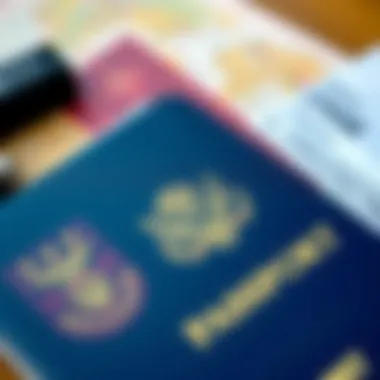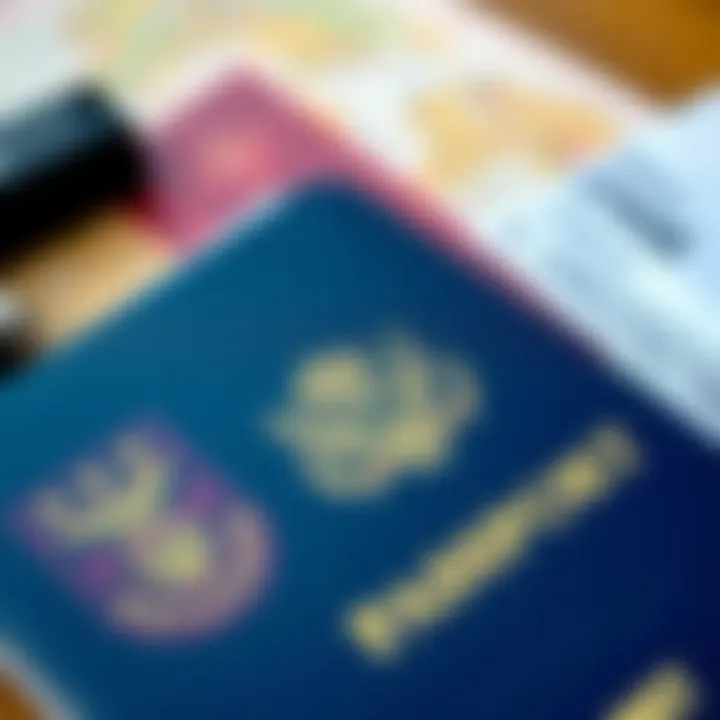Checking Your Visa Status with Passport Number


Intro
Checking your visa status can often feel like finding a needle in a haystack, especially when relying solely on your passport number. This ability to verify your visa is not just about keeping yourself updated but is crucially tied to your ongoing legal residency, investment opportunities, and sometimes, even property ownership. In a bustling city like Dubai, where the expat community thrives, understanding the nuances of visa validation using your passport number becomes imperative.
The intricacies involved can be daunting. However, armed with the right knowledge and resources, checking your visa status can be a straightforward process. This guide aims to light up that path, providing practical steps, resources, and information to navigate through any complications that might arise in your immigration journey. You may be an expatriate keen on investing, a potential homebuyer, or a seasoned developer; this article serves as your compass.
By sifting through the specific legal requirements and challenges that applicants often encounter, we hope to empower you with the needed insights to ensure your status remains clear and unchallenged. The stakes in Dubai aren't small—whether it’s securing a lucrative investment opportunity or maintaining legal residency, every detail counts. Let’s get started.
Understanding Visa Status
Visa status refers to the current situation of a visa application, encapsulating whether it is pending, approved, or rejected. This concept is particularly vital for expatriates, investors, and homebuyers, as a clear understanding of visa status can directly affect their ability to reside, work, or conduct business in a foreign country. Comprehending visa status not only aids in navigating the often-complex immigration landscape but also enables individuals to plan their future steps with greater confidence.
Definition of Visa Status
Visa status is essentially a marker that indicates the standing of a visa application. It involves several classifications, such as:
- Pending: When an application is under review and no decision has yet been made.
- Approved: This indicates the application has been positively processed, granting the applicant the right to enter or reside in the country.
- Rejected: Shows that the application has been denied and the applicant will need to understand the reasons for this outcome.
Understanding these definitions is crucial, as it lays the groundwork for further actions. For instance, if an investor knows their status is pending, they can keep an eye on the application while preparing for their next steps in the new country.
Importance of Checking Visa Status
Checking the visa status is like having a compass in the vast sea of immigration. Here are a few key reasons why it is essential:
- Planning: Knowing whether one's application is still in the works or already settled allows individuals to make informed decisions about housing, employment, or travel.
- Avoiding Uncertainty: Being in limbo without knowledge of one’s visa status can create anxiety. Regularly checking can alleviate this worry and provide peace of mind.
- Addressing Issues Early: If there are complications or errors in the visa application, identifying these concerns promptly may prevent further delays.
"Being informed is half the battle; it can turn the tide in uncertain situations."
In summary, understanding visa status and regularly checking it are integral parts of managing immigration processes. They help ensure that individuals can approach their relocation goals effectively and with minimal headaches. This knowledge empowers expatriates, investors, and others in their endeavors abroad, helping them navigate the maze of immigration with confidence.
The Role of Passport Number
The passport number is more than just a sequence of digits; it’s a key that unlocks access to a world of international travel and residency opportunities. Understanding its role in the context of checking visa status is crucial for anyone navigating the immigration landscape. For expatriates, investors, and homebuyers looking to settle or transact in places like Dubai, a clear grasp of their passport number’s utility is not merely advantageous, it is essential.
What is a Passport Number?
A passport number is a unique identifier assigned to your passport, like a fingerprint for your document. It’s typically a combination of letters and numbers, and is used by governments to track and manage individual travel documents. This number is vital for a variety of reasons: it verifies your identity and proves your citizenship when you’re abroad. When submitting a visa application, this number often becomes part of your digital trail, linking you to records of your travel history.
The structure of a passport number can differ by country. For instance, U.S. passport numbers are numeric and usually consist of nine digits, whereas Canadian passports feature letters and numbers combined in a different format. Though the arrangement may vary, its primary function remains the same globally, creating a secure and efficient means of identification for traveling individuals.
Moreover, passport numbers serve as a safeguard against fraud. They help ensure that only legitimate holders can travel, thereby upholding the integrity of international border controls. For expats and investors checking their visa status, knowing your passport number is indispensable to accessing personal information through official channels.


How Passport Number Relates to Visa
Understanding how your passport number correlates to your visa status is vital for simplifying the verification process. Your visa is directly associated with your passport number in government databases. When you apply for a visa, whether as an investor in real estate or as an expatriate seeking residency, your passport number is an integral part of your application.
When checking your visa status, you will likely be prompted to enter your passport number, further emphasizing its role. Not only does this number identify you, it also retrieves records relevant to your specific visa application, such as its status—whether it’s approved, pending, or rejected.
This connection underscores the necessity of keeping your passport number handy during the visa verification process. Forgetting it could lead to delays or complications, especially when communicating with embassies or consulates, or when utilizing online platforms designed for visa checks. Overlooking this small but mighty number can impede swift access to vital information, further complicating an already complex journey.
It’s also worth noting how different countries might handle the relationship between passports and visas. For instance, in regions like the Middle East, the connection may be more pronounced due to strict regulations. Knowing the specifics about how your passport number influences visa-related procedures empowers you with foresight, allowing for smoother navigation of the often-challenging immigration maze.
"Your passport number is not just digits; it’s your gateway to the world. Understanding its implications can save you time and stress in your immigration journey."
In summary, the passport number is not only a required piece of information for identifying oneself, but also a critical component in the process of checking visa status. Developing an understanding of this interplay can ease the pathways for expatriates, investors, and other stakeholders as they maneuver through visa applications and monitoring in their quest for new opportunities.
Step-by-Step Process for Checking Visa Status
Understanding how to check visa status is crucial for individuals navigating the complexities of immigration, particularly in foreign countries like Dubai. This process is not merely a luxury; it’s a necessity for those who require regular updates on their legal status. Being aware of one's visa status helps in avoiding unnecessary complications and contributes to a smoother stay and transition.
Gather Necessary Information
Required Documents
Before diving into the process of checking your visa status, gathering the right documents is essential. The primary document you will need is your passport, which uniquely identifies your travel history and immigration status. Apart from that, it's often wise to have a copy of your visa application or any communication from the immigration office handy. A well-maintained record of these documents enables a seamless inquiry, reducing time and hassle.
Having the required documents not only helps in speeding up the verification process but also ensures that you’re prepared for any follow-up questions that may arise during the inquiry. Therefore, treating this list of required documents with importance can lead to a smoother journey.
Information to Collect
When checking your visa status, there are specific pieces of information that you need to have at your fingertips. The most significant element is your visa application number. This number, alongside your passport number, serves as a key to unlock your application details. It enables the system to direct you to the correct records without unnecessary detours.
Additionally, be prepared to provide personal details like your full name, date of birth, and nationality. Collecting this information before starting your inquiry streamlines the process, allowing you to focus on obtaining your visa status without any distractions or delays.
Using Online Platforms
The digital age has made things easier, and checking your visa status is no exception. Online platforms have taken the hassle out of the process, bringing it right to your fingertips.
Official Government Websites
Official government websites serve as the most reliable source for checking visa status. Websites, such as the UAE Government's portal, are designed for this very purpose. Using these platforms ensures that any information you receive is accurate and directly sourced from immigration authorities.
A key characteristic of these official sites is that they often have secure access protocols in place, safeguarding your personal information. But, beware that navigating these sites can sometimes be a bit complex, particularly if you are unfamiliar with the format. Still, the benefit of direct information often outweighs any minor difficulties that could arise.
Third-Party Tools


While official sites are preferred, there are also third-party tools available that claim to help users check their visa status. These platforms can aggregate various sources of information, presenting data in a user-friendly manner. However, use these tools with caution. The unique feature of many third-party tools is their convenience; they are often more intuitive and user-friendly than official government websites.
Nonetheless, exercise discretion as the accuracy of the information provided may not always meet that of a government website. Some users appreciate the quicker access to their results these third-party tools can provide but must keep in mind that their reliability could vary.
Contacting Relevant Authorities
Sometimes, the digital route may not yield the results you need. When that happens, reaching out directly to relevant authorities becomes necessary.
Embassies and Consulates
Embassies and consulates are valuable resources for anyone looking to check their visa status. Their representatives are generally well-versed in immigration matters and can provide personalized assistance. A notable advantage of this route is that representatives can address specific inquiries you might have, providing more tailored guidance than a website might.
However, getting in touch can come with longer wait times compared to online options. Some individuals find standing in long lines to be a considerable disadvantage.
Visa Application Centers
Visa Application Centers (VACs) are another point of contact for checking visa status. These centers can assist with various processes related to visa applications and are often conveniently located. They act as a bridge between you and the immigration authorities, making them an adept choice for processing inquiries.
While their in-person assistance can be beneficial, one should expect certain limitations regarding what information they can provide. The centers may handle a high volume of requests, which could lead to waiting time.
Common Issues in Visa Status Verification
Checking your visa status may seem straightforward, but a number of common issues can arise that complicate the process. Recognizing these problems is vital for ensuring that your visa application is in good standing and for avoiding unnecessary delays in your travel plans. Basically, knowing what could go wrong can save you from a heap of trouble down the road. Addressing these issues head-on helps make the verification process a smooth ride.
Incorrect Information
When it comes to visa status, providing the right information is crucial. Incorrect details can stall the verification process or lead to outright rejection of your inquiry. This can happen for various reasons—typos in passport details, wrong visa application numbers, or even mix-ups with family members’ data. Mistakes happen, but navigating them requires some serious diligence.
How to Avoid Errors
One main aspect of avoiding errors is double-checking all the information required for the verification process. This includes not just your passport number but also details like your full name as it appears on the passport and the visa application number itself. If verification requires additional credentials or documents, ensure they are all correct and up to date. A major benefit here is that by meticulously reviewing these details, you considerably reduce your chances of dealin’ with the consequences of misinformation. The key characteristic of this method lies in its simplicity—just take your time and verify before submission. An effective feature of this approach is that it can save you from headaches later on, although it can take a bit more time upfront.
Rectifying Mistakes
Mistakes do happen, and realizing you entered the wrong passport number can be frustrating. The good news is that rectifying mistakes in most systems is relatively straightforward. If the online system flags your information as incorrect, many platforms allow you to edit your submission directly. Alternatively, if your application error occurred at an official office, you may need to provide a written explanation and possibly additional documentation.
Highlighting a critical characteristic, quick action is often crucial when rectifying such errors. The longer you wait, the more complications may rise. Getting on top of this sooner rather than later often proves to be beneficial in maintaining your original timelines. While sometimes it involves a bit of paperwork and wait time, managing mistakes promptly can often lead to relief.
System Errors
Sometimes, it’s not you but the system that throws a wrench in your plans. System errors occur for various reasons, including high traffic on the website you're using, outdated systems, or even bug-related issues. Understanding these failures can help you navigate your visa status check with more ease, especially in the digital age.
Understanding System Failures


Recognizing system failures is essential for troubleshooting. If you encounter a failure message while trying to verify your visa status, the first step is to remain calm. Knowing that this could be a temporary issue often alleviates some of the stress; it might be a bug or maintenance on the server side. Understanding the nuances of system failures could save you a lot of time and effort. One key characteristic of this problem is its unpredictability—it might not even be due to your submission. A common pitfall in this instance is not being patient and repeatedly trying to input your information, which might worsen the situation, leading to a temporary ban on your submission attempts.
Steps to Resolve Technical Issues
When you encounter a technical issue, it’s vital to take systematic steps to resolve it. Start by refreshing the web page or trying the task on a different browser. If the problem persists, clear your browser's cache or cookies, then try again. If none of these solutions work, reach out to customer service or technical support of the pertinent agency, detailing the problem clearly. A big upside of this approach is that it often leads to a quicker resolution, especially if you provide sufficient context to help tech support assist you better.
In summary, being proactive about verifying your visa status will minimize hurdles, pave the way for smoother transitions into travel, and ultimately enlighten your journey in a world that often feels increasingly complicated.
Navigating the maze of visa status verification can feel daunting, but understanding and tackling these common issues head-on often leads to more efficient travel experiences.
Legal Considerations
When dealing with visa status, understanding the legal landscape is crucial. The implications of your visa status are manifold, and a clear grasp of your rights and responsibilities underpins a successful journey, whether you're an expatriate, investor, or homebuyer. The legal context surrounding visa checks using a passport number highlights not only the procedural aspects but also the importance of safeguarding personal information.
Privacy and Data Protection
In today's digital age, concerns over privacy and data protection have become more pronounced. When you check your visa status using your passport number, you're sharing sensitive personal details. Here’s why you need to be aware of privacy considerations:
- Data Security: Always ensure that the websites and platforms you use to check your status are secure. Look for HTTPS in the URL, which signifies a secure connection.
- Authorized Access: It’s vital to utilize official channels. Using government or authorized websites helps ensure your data isn't misused. This limits exposure to potential data breaches, safeguarding your personal information.
- Ownership of Data: You should know that you have the right over your data. According to privacy laws in various countries, you can request access to any information held about you. If there are discrepancies or errors, you have the right to correct them.
"The key to any successful inquiry is not just finding information, but knowing your rights when it comes to your data."
Being aware of privacy policies and choosing the most secure platforms can go a long way in protecting yourself in this digital realm.
Rights of Applicants
Rights of applicants are central to the visa process and should never be overlooked. Here are the fundamental considerations:
- Right to Information: As an applicant, you have the right to receive all pertinent information regarding your visa status. This includes clarity on processing times and any issues that may arise with your application.
- Right to Appeal: If your visa status is denied, laws often provide you the right to appeal that decision. Knowing the correct channels and procedures is essential for exercising this right.
- Right to Fair Treatment: It’s paramount that all applicants are treated with fairness throughout the visa-checking process. Discrimination, if faced, can be reported to the relevant authorities, often leading to investigations and corrective measures.
- Right to Confidentiality: Your visa application and status should remain confidential, exposed only to official entities necessary for its processing. Unauthorized sharing can lead to legal repercussions for the institutions involved.
Understanding these rights not only empowers applicants but also guarantees a smoother process. Leverage this knowledge to navigate your visa requirements effectively.
By placing these legal considerations front and center, you’re better prepared to handle the intricacies of checking your visa status. It’s more than just a series of steps; it’s about ensuring your journey is secure and informed.
Visa Commonly Asked Questionss
Visa FAQs serve as a go-to hub for individuals with pressing concerns and inquiries. Having a clear grasp of frequently asked questions can significantly ease the process of checking one's visa status.
- Common Questions: This section addresses typical queries that applicants may have, such as "How long does it take to receive visa approval?" or "What if my status is still pending?". These FAQs can save time and eliminate unnecessary confusion, providing straight answers to oft-asked questions.
- Evolving Information: Visa policies may change frequently; thus, staying updated without sifting through hefty documents is crucial. FAQs often reflect these changes, allowing applicants to adjust their expectations and plans accordingly.
Contact Information for Government Agencies
When in doubt or faced with specific issues regarding your visa status, reaching out to government agencies becomes imperative. Each country's regulations vary, and connecting with the appropriate department can facilitate a smoother experience.
- Embassies and Consulates: These offices are on the front lines of visa processing and can provide tailored assistance depending on individual situations. Most embassies and consulates have dedicated contact pages, allowing you to reach the right department or personnel.
- Visa Application Centers: Often, local visa application centers act as intermediaries. They can have a wealth of information, not just on visa status but also on the entire application process. Remember, however, that response times may vary, so it's wise to plan ahead.
Important: Always ensure you're using official channels when seeking assistance, as this can help you avoid misinformation and potential scams. Refer to official government websites, identified by their *.gov domains, for the most reliable information.
Incorporating these additional resources transforms your visa status verification from a daunting task into a manageable process, enabling you to proceed confidently on your immigration journey.



